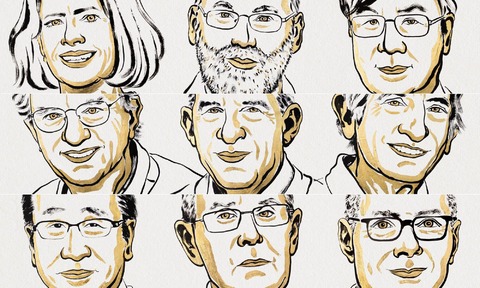Immunology, quantum and MOF dominate Nobel Prizes for science
9 Oct 2025

Nine new Nobel Prize laureates have shared the three award categories for physiology/medicine, physics and chemistry.
They received their accolades in recognition of their respective work on immune tolerance, quantum physics and molecular architecture.
Mary E. Brunkow (Institute for Systems Biology, Seattle), Fred Ramsdell (Sonoma Biotherapeutics, San Francisco), and Shimon Sakaguchi (Osaka University) won the Nobel in physiology or medicine.
British academic John Clarke (UC Berkeley), Michel H. Devoret (Yale and UC Santa Barbara) and John M. Martinis (UC Santa Barbara) were awarded the physics prize “for the discovery of macroscopic quantum mechanical tunnelling and energy quantisation in an electric circuit”.
Susumu Kitagawa (Kyoto University), Richard Robson (Melbourne) and Omar M. Yaghi, (UC Berkeley) received the chemistry prize for the development of metal–organic frameworks.
Each prize is worth 11 million Swedish kronor (equivalent to £870,00), to be shared equally between the laureates who receive individually the equivalent of c.£290,000.
Science awards are hosted at Sweden’s Karolinska Institute, with physiological and medicine awards presented by the Nobel Assembly.
Brunkow, Ramsdell and Sakaguchi’s work on peripheral immune tolerance was celebrated by the president of international body The Physiological Society, professor Annette Dolphin, who outlined the impact of their research.
“Their pioneering work has revealed how the immune system is kept in check by regulatory T cells, preventing it from mistakenly attacking the body’s own tissues. These discoveries have been decisive for understanding why most of us do not develop serious autoimmune diseases.
“By uncovering the mechanisms of peripheral immune tolerance, this research provides vital insights into the regulation of the immune system and opens up new possibilities for treating autoimmune diseases, improving transplant outcomes, and developing future cancer therapies.
She described the work as a striking example of how fundamental physiological research could have far-reaching implications for human health.
The physics and chemistry Nobel Prizes were awarded by the Royal Swedish Academy of Sciences.
It cited Clarke, Devoret and Martinis’s discovery of “macroscopic quantum mechanical tunnelling and energy quantisation in an electric circuit”, addressing a key question in physics; the maximum size of a system that can demonstrate quantum mechanical effects.
The trio’s experiments demonstrated quantum mechanical tunnelling and quantised energy levels in a system sufficiently large to be held in the hand.
“It is wonderful to be able to celebrate the way that century-old quantum mechanics continually offers new surprises. It is also enormously useful, as quantum mechanics is the foundation of all digital technology,” says Olle Eriksson, chair of the Nobel Committee for Physics.
The academy also praised Kitagawa, Robson and Yaghi’s development of “a new form of molecular architecture” in which metal ions function as cornerstones linked by long organic carbon-based molecules. Metal ions and molecules form crystals that contain large cavities, porous materials – known as metal–organic frameworks (MOF) – are designed to capture and store specific substances, drive chemical reactions or conduct electricity.
“Metal–organic frameworks have enormous potential, bringing previously unforeseen opportunities for custom-made materials with new functions,” said Heiner Linke, chair of the Nobel Committee for Chemistry.
In 1989, pioneered the molecular construction, while Kitagawa predicted that MOFs could be made flexible and Yaghi created a stable MOF and showed that it could be modified.
Director of Sydney university Net Zero Institute, Professor Deanna D’Alessandro called Robson’s contribution “a powerful example of how years of sustained effort and support on long-term scientific research leads to real-world impact …at a time when the value of research is under debate”.
She added: “What began as fundamental scientific curiosity has grown into a transformative innovation - MOFs are now helping solve some of the world’s biggest challenges, from greenhouse gas capture and catalysis to drug delivery and medical imaging.”
The United States was strongly represented among the winners with two thirds of recipients linked to US-based institutions and universities. Of these, five were sited in California, with four linked to the University of California.
However, the sole British Nobel science recipient, UC Berkeley-based professor John Clarke warned that Federal cuts to science funding could “cripple” much of US science research unless this action was reversed (cClick below for link to Reuters’ video).
For more information about the 2025 Nobel prizes, click here.
PIC: Images by Niklas Elmehed © Nobel Prize Outreach depict Top row: Brunkow, Ramsdell, Sakaguchi (Physiology or Medicine); Middle: Clarke, Devoret, Martinis (Physics); Bottom: Kitagawa, Robson, Yaghi (Chemistry)

